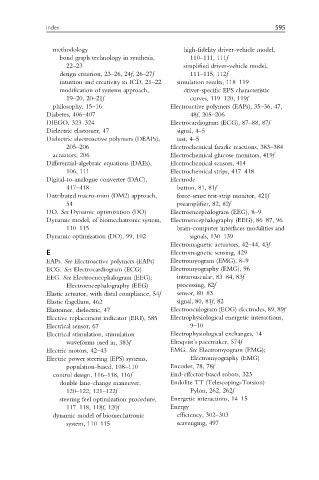Page 603 - Handbook of Biomechatronics
P. 603
Index 595
methodology high-fidelity driver-vehicle model,
bond graph technology in synthesis, 110–111, 111f
22–23 simplified driver-vehicle model,
design criterion, 23–26, 24f,26–27f 111–115, 112f
intuition and creativity in ICD, 21–22 simulation results, 118–119
modification of systems approach, driver-specific EPS characteristic
19–20, 20–21f curves, 119–120, 119f
philosophy, 15–16 Electroactive polymers (EAPs), 35–36, 47,
Diabetes, 406–407 48f, 205–206
DIEGO, 323–324 Electrocardiogram (ECG), 87–88, 87f
Dielectric elastomer, 47 signal, 4–5
Dielectric electroactive polymers (DEAPs), test, 4–5
205–206 Electrochemical faradic reactions, 383–384
actuators, 206 Electrochemical glucose monitors, 419f
Differential-algebraic equations (DAEs), Electrochemical sensors, 414
106, 111 Electrochemical strips, 417–418
Digital-to-analogue converter (DAC), Electrode
417–418 button, 81, 81f
Distributed macro-mini (DM2) approach, force-sense test-strip monitor, 421f
54 preamplifier, 82, 82f
DO. See Dynamic optimization (DO) Electroencephalogram (EEG), 8–9
Dynamic model, of biomechatronic system, Electroencephalography (EEG), 86–87, 96
110–115 brain-computer interfaces modalities and
Dynamic optimization (DO), 99, 102 signals, 130–139
Electromagnetic actuators, 42–44, 43f
E Electromagnetic sensing, 429
EAPs. See Electroactive polymers (EAPs) Electromyogram (EMG), 8–9
ECG. See Electrocardiogram (ECG) Electromyography (EMG), 96
EEG. See Electroencephalogram (EEG); intramuscular, 83–84, 83f
Electroencephalography (EEG) processing, 82f
Elastic actuator, with distal compliance, 54f sensor, 80–83
Elastic flagellum, 462 signal, 80, 81f,82
Elastomer, dielectric, 47 Electrooculogram (EOG) electrodes, 89, 89f
Elective replacement indicator (ERI), 585 Electrophysiological energetic interactions,
Electrical sensor, 67 9–10
Electrical stimulation, stimulation Electrophysiological exchanges, 14
waveforms used in, 383f Elmqvist’s pacemaker, 574f
Electric motors, 42–43 EMG. See Electromyogram (EMG);
Electric power steering (EPS) systems, Electromyography (EMG)
population-based, 108–110 Encoder, 78, 78f
control design, 116–118, 116f End-effector-based robots, 323
double lane-change maneuver, Endolite TT (Telescoping-Torsion)
120–122, 121–122f Pylon, 262, 262f
steering feel optimization procedure, Energetic interactions, 14–15
117–118, 118f, 120f Energy
dynamic model of biomechatronic efficiency, 302–303
system, 110–115 scavenging, 497

